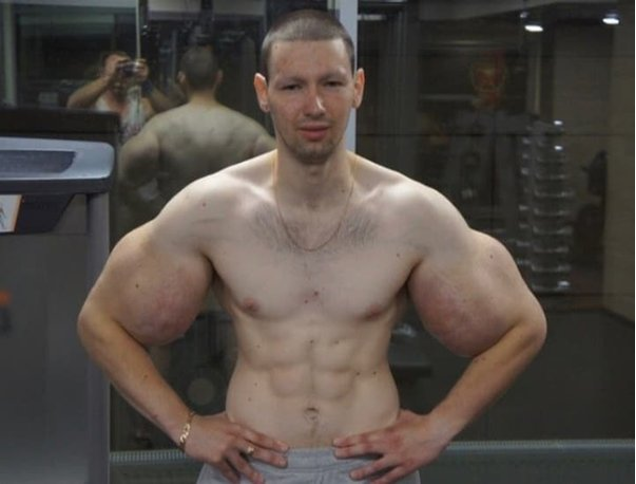Tagged: pitching
Bigger Arms = Bigger Velocity?!?!?!
Bigger biceps and triceps can increase throwing velocity!!!!
If this isn’t a headline that grabs the attention of every young baseball player then I don’t what would. This isn’t even an attempt to create some clickbait on my end either. There’s some peer-reviewed research that suggests that bigger arms, bi’s and tri’s, can help improve throwing velocity.
Here are some research headlines:
- Southard et al. (1998) reported a 15% increase in hand speed when 1.4 kg was added to the upper arm
- Linthorne et al. (2020) saw upwards of a 7% increase in throwing distance with javelin throwers
- Fasbender et al (2020) reported that an increase in weight of the upper arm increased velocity while weight added to the forearm decreased throwing velocity.
Before we go putting a preacher curl bench in the bullpen let’s dig into the details so we can make some educated decisions.
The Whip Effect
The theory that bigger arms, upper arms to be specific, centers on the concept that the arm functions similarly to a “whip” during the throwing motion. What makes a whip effective in creating velocity is that it is heaviest at the handle and lightest at the tip. This gradient in mass, decreasing from proximal (near the body) to distal (toward the end of the arm), plays a crucial role in achieving the highest attainable velocities.
This “whip” analogy is compelling because of its universal visual appeal and, more importantly, its accurate reflection of the arm’s dynamic in motion.
The whip-like action materializes when the larger and more proximal part of the chain—specifically, the upper arm—decelerates, transferring its angular momentum to the lighter, distal segment composed of the forearm and hand, thereby leading to an increase in velocity.
Whip-like coordination is also used in kicking movements, and the mass difference between the thigh and shank segments is believed to enhance the kicking action.
This leads us to the question of what is the ideal shape of the arm if we are concerned with creating elite levels of throwing velocity.
On average, the upper arm is 75% bigger than the forearm segment (6,7). But is this an ideal ratio? What would happen if you messed around with this ratio and placed more weight on either the distal (forearm) or proximal (upper-arm) portion of the arm.
This leads us back to those three studies that I referenced earlier.
Studies
Our first study, Fasbender et al (2020), found that an increase in upper arm mass would increase velocity. The weight of the upper had to be around 5-6 kg. This is a lot; the average human arm is only around 2.1 kg. So, this seems unrealistic so maybe not so useful to us in the baseball world.
The type of throw they used however looks nothing like what we see on a mound. The subject was attached to a chair and was only able to access the sagittal plane. Imagine a one-handed soccer throw-in with a tennis ball while being strapped into a seat.
They had to restrict the throw like this to truly determine how the mass of the upper and lower segments of the arm contribute to throwing velocity. When the arm moves like this it is called a “double pendulum” and a lot of other sporting movements like soccer kicks, golf swings, and baseball swings have been analyzed like this using computer models.
Our second study, Linthorne et al. (2020), used real-life throwing. These researchers recruited 3 decathletes for this study and examined the differences in their javelin throw with different amounts of weight attached to the middle of the upper arm ranging from 0 to 3.3 lbs.
This study was conducted inside using a javelin ball (800 g/28 oz) and the participants were restricted to a short run-up.
The throwing distance was calculated by ball velocity which was determined by the distance the ball traveled in the 10 frames after ball release using a high-speed camera. Release height and release angle were very similar across all throws with the various weights.
The optimal weight for two of the participants was 21 and 7 ounces which increased their performance compared to their throws with no additional load by 7 and 4% respectively. These subjects are high-level throwers already so an improvement like this is the difference between winning and losing.
The other participant had their best throw with no added mass. Maybe this athlete already had an optimal ratio of lower to upper arm mass or maybe the added mass negatively alerted their throw. Surely adding extra weight to your arm affects biomechanics.
How the added mass changes throwing mechanics was the aim of our final study. The one that reported a 15% increase in velocity when mass was added to the upper arm.
This study, Mass and Velocity: Control Parameters for Throwing Patterns by Southard in 1998, looked at how throwing mechanics with a 4 oz ball differed with:
- varying levels of intensity (25,50,75, and 100%)
- subjects with different levels of throwing efficiency
- load added to the arm at either the
- distal (forearm)
- proximal (upper arm)
This was a pretty cool study; its primary focus was to explore motor control seeing if the different weight distributions along the arm changed the actual throwing mechanics. I’m going to try and focus on that portion of this study in a future article. Right now, we are interested more interested in how velocity was affected.
Here’s a quote from their summary:
“Interestingly, the increase of mass to only the most proximal segment (upper arm) resulted in an increase in the velocity of the hand across levels of throw. This is not surprising, because an increase in the mass of the humerus would require a greater increase in the velocity of the more distal segments to maintain angular momentum.”
That last term “maintain angular momentum” basically means that once something is moving it wants to keep moving unless there are forces that will slow it down. In this case, having a forearm that is too heavy would be a force that would reduce angular momentum. Here’s another statement they made that supports this.
“Adding mass to the more distal segments would have the opposite effect of adding mass to the proximal segments. The increase in proportionate mass of the distal segment would not promote segmental lag, because attempts to conserve angular momentum would not increase velocity of the equally massive distal segment”
What they are saying here is that if the forearm is too massive there can’t be that slight delay, or lag, between when the upper arm and forearm reach their respective peak velocities. Pitching is a series of segmental lags. The lag between your hips and shoulders rotating, the lag between your shoulder and upper arm, and in this case, the lag between the upper arm and forearm.
Conclusion
So, before we start strapping weighted bands to the upper arms of our pitchers or making them do hour-long arm workouts every day, let’s remember what we learned from these studies
- One study used a 4 oz with various levels of throwers.
- One study used a 28 oz javelin ball with a running start
- One study used a tennis ball with a sagittal plane type of throw while seated.
None of these are specific enough to baseball for us to say that this works. That being said, it is intriguing and that’s the first step to answering new questions like:
- What’s the ideal forearm-to-upper-arm ratio?
- Maybe forearms that are too heavy make you a candidate for a Tommy John surgery.
- Would using added mass to the arm help develop throwing velocity due to an overload
- Would adding mass to the forearm help increase layback and change throwing mechanics for the better
Who knows?
I’ll follow this article up with another piece where I explore some ideas about this concept.
Thanks for reading,
Graeme Lehman, MSc, CSCS
References
- Mass and Velocity: Control Parameters for Throwing Patterns. Dan Southard. Research Quarterly for Exercise and Sport ©1998 by the American Alliance for Health, Physical Education, Recreation and Dance Vol. 69, No.4, pp.355-367
- Attaching mass to the upper arm can increase throw distance in a modified javelin throw. NICHOLAS LINTHORNE, MARTIN HEYS, TOMAS REYNOLDS, NILS ECKARDT. Article in Acta of Bioengineering and Biomechanics · June 2020
- Optimal mass of the arm segments in throwing: A two-dimensional computer simulation study, Patrick Fasbender, Thomas J. Korff, Vassilios B. Baltzopoulos & Nicholas P. Linthorne (2020): European Journal of Sport Science, DOI: 10.1080/17461391.2020.1730446
- The Science of Soccer, WESSON J., Institute of Physics Publishing, 2002. (Hirashima, Yamane, Nakamura, & Ohtsuki, 2008).
- de Leva, P. (1996). Adjustments to Zatsiorsky-Seluyanov’s segment inertia parameters. Journal of Biomechanics, 29(9), 1223–1230.
- Winter, D. A. (2009). Biomechanics and motor control of human movement (4th ed.). New York, NY: John Wiley.






